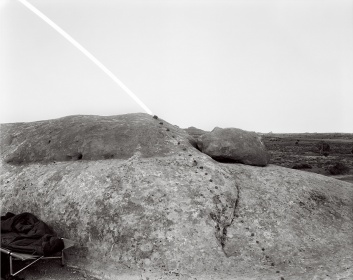
In the series Of Heaven and Earth, I address my place on both the human—and cosmic—scale. The photographs are constructed by marking the land in front of my camera in such a way that the path of heavenly bodies interacts with the marks that I have made. To orchestrate these interactions, I must take very careful measurements based on my camera position and the position of the sun or moon in the coming hours.
To produce each photograph, I leave open the shutter for a very long exposure. The result is an image of the moon or sun playing off of an altered landscape. In this way, the heavenly meets with the human, the immense with the intimate and one of the most constant forces in our world—the movement of the solar bodies—interacts with a line of rocks or grass: a mark that is small and completely fleeting in meaning and form.
This work stems from the gap between the knowledge of the vastness of time and space and the unshakable notion that the tiny acts we engage in each day matter. From our notions of belonging to the land and the land belonging to us. From the allure of the single-point perspective that photography gives us. Indeed, the meaning of my marks is only evident from one vantage point (the camera’s) and for just one night. So, these photos are about the importance of a few hours in a very specific place, alongside the importance of the eternal and unending scale of time and space itself. They are about mortality. Long after the lines I have made disappear into the land, indeed long after I am dead, the moon will continue on its elliptical path. I make these photographs to draw a line between these two modes of understanding the world.
—David Shannon-Lier













